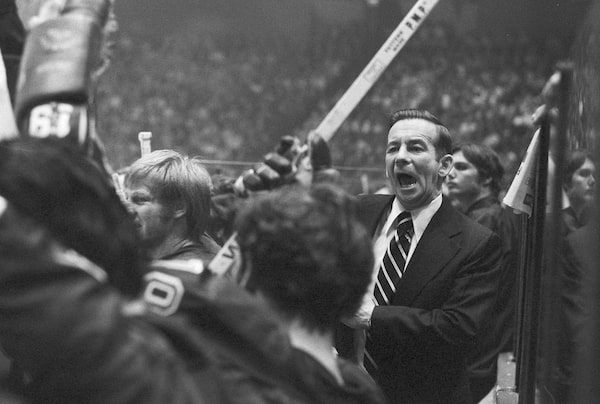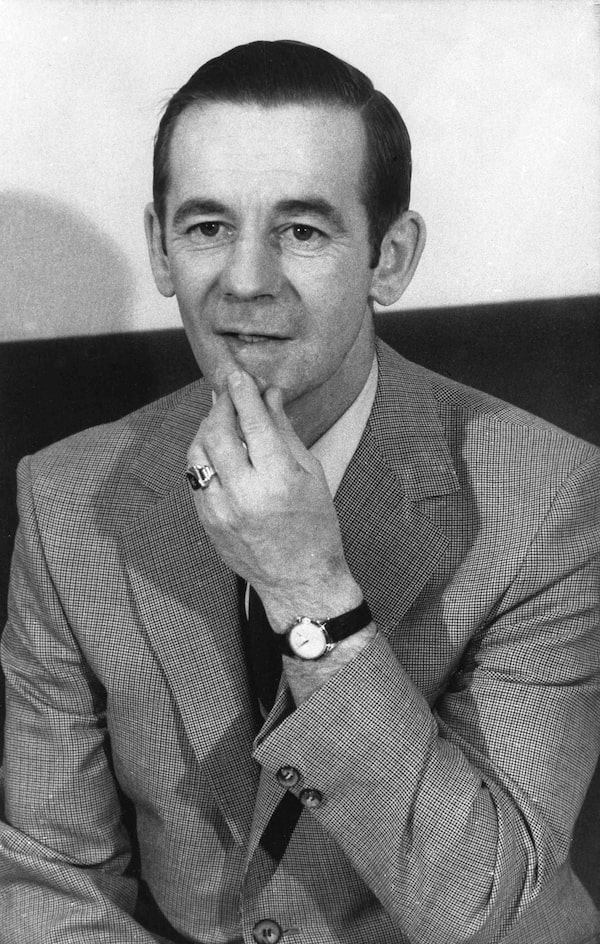
New York Rangers coach Emile Francis shouts after the Rangers scored against the Philadelphia Flyers during the second period of an NHL hockey game in Philadelphia in April 1974.Brian Horton/The Associated Press
Championships are wonderful but they aren’t everything.
Emile Francis never won the Stanley Cup in a professional lifetime in hockey as a player, coach and executive, but this man of slight stature who introduced the goaltender’s trapper glove endures as a giant for his achievements and personality. Mr. Francis died Saturday at the age of 95.
The high point of his five-decade hockey career came in the period when the National Hockey League was expanding from a modest six-team group to a business enterprise three times that size from the mid-1960s to the mid-70s. Taking over the New York Rangers operation that had languished in the depths of the standings for two decades, Mr. Francis built a formidable team that couldn’t quite overcome more powerful teams in Montreal, Boston and Chicago.
Nicknamed “The Cat” for his quickness while playing junior hockey, Mr. Francis was a goaltender who, at 5-foot-7 and no more than 155 pounds, was undersized even by the standards of the day. Even as a boy growing up in North Battleford, Sask., he compensated for that with a sharp and creative mind.
“I was always a little guy, so I had to rely on my wits – and no one was going to cheat me out of anything,” Mr. Francis recalled in an interview with this reporter in 2003. “Sister Mary Berchmans taught me that in grade school at the Convent of the Child Jesus School in North Battleford. I was in goal in a straight-time one-hour game against Connaught School for the elementary school championship. Every chance I got I flipped the puck over the boards into the snow, which was okay according to the rules then.
“We won 1-0 but Connaught wouldn’t give us the trophy because of my tactic. When we told Sister Mary about it, she took me along to Connaught School in a taxi, barged right in on the principal, who was also their hockey coach, and demanded the trophy. We took it back and Sister Mary declared a school holiday.”
Emile Francis was born Sept. 13, 1926, in North Battleford. His adolescence was sharply affected by the Second World War, but the quirks of his age, the war’s effect on the NHL, and his eligibility to serve kept him off the battlefields.
“American hockey teams were so desperate for players during the Second World War that they were recruiting teenagers,” Mr. Francis said. “I was barely past my 17th birthday and playing goal for Philadelphia Falcons, and then the Washington Lions, of the Eastern ‘Amateur’ Hockey League.”

Nicknamed 'The Cat' for his quickness while playing junior hockey, Mr. Francis was a goaltender who, at 5-foot-7 and no more than 155 pounds, was undersized even by the standards of the day.Harry Harris/The Associated Press
He enlisted in the Canadian army when he was old enough but the war ended before he could go overseas and he was discharged in 1945. “At 19 I still had a year of junior hockey eligibility left, so I joined the Moose Jaw Canucks.”
Moose Jaw went undefeated in the Saskatchewan Junior Hockey League’s 1945-46 campaign before being eliminated in Memorial Cup playdowns. Mr. Francis was so impressive that he split the following season between the senior Regina Capitals and the Chicago Black Hawks of the NHL, where he bucked authority to make a goaltending innovation that was as significant as Jacques Plante’s introduction of facial protection a decade later.
“I created the first trapper,” he said. “Until then, the two goalie gloves were basically identical, blockers with just a little webbing between the thumb and fingers. If you actually tried to catch the puck in your palm, it would knock the hell out of your hand. So I took a George McQuinn model baseball mitt – he was a first baseman for the St. Louis Browns – and stitched it onto a regular hockey glove. No one said anything about it until my first NHL game with the Chicago Black Hawks. We’re about to start when King Clancy, who’s refereeing the game, is called over to the bench by Jack Adams, Detroit’s coach. Adams says something, points at me, and Clancy skates over to my net.
“‘Let me see that glove,’ Clancy says. He looks over my trapper and tells me, ‘It’s illegal. You can’t use it.’
“‘Well, then,’ I say, ‘you don’t have a game because this is the only glove I’ve got!’ I had him there. Teams dressed only one goalie and it would look stupid to bring the emergency goalie down from the stands when the starter is perfectly healthy. Clancy lets me use the glove, but orders me to take it to league president Clarence Campbell that weekend when we’re in Montreal so he could rule on it. Campbell approved it and trappers quickly became standard equipment.”
Ultimately, Mr. Francis was unable to measure up to NHL standards over the long haul. With only six teams in the league carrying one goalie apiece, there wasn’t much of a major-league future for someone who was merely Top 10 material. After a couple of seasons with the Black Hawks, he was dealt to the New York Rangers, for whom he appeared only sparingly.
“You look at my career NHL line and it’s not much: 95 games, a 31-52-11 record and 3.75 goals-against average,” Mr. Francis said. “But every year I played 50 to 70 games, plus playoffs, for American Hockey League teams in New Haven, Cincinnati and Cleveland, and around the old professional Western Hockey League for Vancouver, Saskatoon, Seattle, Victoria and Spokane.”
Mr. Francis, however, was building up a wealth of knowledge about coaching and running teams, augmenting his hockey experience with summers spent as player-manager of North Battleford’s semi-pro baseball team. The sport was immensely popular in his home province in the 1950s.
“Every summer I played baseball in Saskatchewan,” Mr. Francis said. “For a while the Bentley family got me to join them in Delisle, but the folks in North Battleford figured my military training made me a good leader and organizer, so I became player-manager of the North Battleford Beavers. Boy, that was good baseball! Some of the best ballplayers around were NHLers like Max and Doug Bentley, Bert Olmstead in Sceptre and Gordie Howe in Saskatoon.
“Our rosters were full of terrific Black ballplayers because the Negro Leagues had disbanded and organized baseball was slow to integrate. League games were great, but the really serious competition was at the tournaments because finishing in the money was what kept your team from going bankrupt.”
Upon retiring from playing hockey in 1960, Mr. Francis was hired by the Rangers to coach their junior team in Guelph, Ont. Two years later he was appointed assistant general manager in New York and in 1964 he was promoted to GM. Early in his tenure, on Nov. 22, 1964, he was the centre of attention in one of the NHL’s most bizarre incidents. In a home game at the old Madison Square Garden against Detroit, Mr. Francis accosted the goal judge who signalled a Red Wings tally and found himself surrounded by hostile fans.
“We end up in a fist fight,” Mr. Francis recalled. “I’m outnumbered three to one and these guys are hammering me good, opening up my face, when Vic Hadfield sees what’s going on from the ice. He jumps on the boards, climbs over the Plexiglas, and half the team follows him. They rescue me and give those guys a licking. The league fined all of us but what really fried me was that the three guys sued me for a million bucks and, after the case dragged through the courts, they got $80,000.”
Mr. Francis took over the Rangers’ coaching reins in 1966, stepping down twice but returning behind the bench after Bernie Geoffrion and Larry Popein were unable to last beyond half a season. As Rangers coach, Mr. Francis posted an impressive record of 342-209-103.
“The Rangers were also-rans when I joined them but we produced good young players like Rod Gilbert, Jean Ratelle and Brad Park, acquired goalie Ed Giacomin from the minors, made some good trades and became solid contenders. We never won the Stanley Cup but we came close, especially in 1972 when everything was in place until Ratelle broke his ankle. We took the Bruins to six games in the final; I know we’d have beaten them with Ratelle in there.
“Managing and coaching the Rangers was aggravating because the Madison Square Garden corporation owned the team and treated it like an afterthought,” he once said, recalling that they had to play playoff games on the road because the circus had priority for April dates. The ice at the Garden was also terrible.
“I blew my top in 1975 when one of our best defencemen, Dale Rolfe, skated over a spot where the ice had worn away and he suffered a terrible broken leg, ended his career right there. ‘I’ve seen better ice on the highways in Saskatchewan,’ I told the reporters, and I meant it. Bill Jennings, the Rangers president, didn’t like when I spoke my mind, which might have had something to do with me being fired in 1976.”
Mr. Francis was soon hired to be general manager for the St. Louis Blues, where his seven-year tenure featured a struggle to keep the team financially solvent. He moved on to a six-year run as president and GM of the Hartford Whalers before retiring in 1989. Neither the Blues nor the Whalers could match the winning consistency of the Rangers, and Mr. Francis was denied the glory of a Stanley Cup title.
“Sure, I had my disappointments” Mr. Francis said, “like playing all those years in the minors and never winning the Stanley Cup, but all the while I had the time of my life.”
He was enshrined as a builder in the Hockey Hall of Fame in 1982. For his contributions to hockey in the United States, he was awarded both the Lester Patrick Trophy and the Wayne Gretzky International Award. He was a long-time member of the Veterans Committee of the Hockey Hall of Fame and became renowned as an exceptional storyteller and ambassador of the game.
He and his wife, Emma, who died in 2020 after 68 years of marriage, had two sons: Bob, who had a brief playing and coaching career with the NHL, and Rick. He leaves both sons.